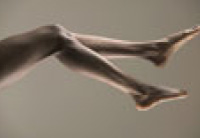Most people with movement disorders are unaware that they are sufferring from them.
 Restless Leg Syndrome (RLS) is a very common problem affecting up to 15 percent of people at some time in their lives. Even though older people are more likely to suffer from the problem, it is still very common in children. Most people describe an uncomfortable feeling in their calves that is usually worse in the evening or at bedtime. People with this problem are often unable to sit still for long periods of time and have trouble travelling long distances in a car or plane. Often these symptoms are troublesome enough to interfere with sleeping, and insomnia can occur from the constant need to move and stretch one’s legs. Periodic limb movement disorder (PLMD) is a variant of RLS, otherwise known as nocturnal myoclonus. This disorder usually manifests with toe and ankle movements in a “jerking” or “kicking” fashion. A person must have at least 4 abnormal motions in a row occurring at least 5 times an hour to be diagnosed with nocturnal myoclonus; twenty percent of people diagnosed with insomnia suffer from PLMD. While thirty percent of cases are known to have a hereditary cause, other reasons for the disorder include anemia, circulatory problems, neural and spinal problems, kidney disorders, alcoholism and vitamin and mineral deficiencies. Medications, smoking, caffeine or temperature extremes may also predispose some people to PLMD. Most people with movement disorders are unaware that they are suffering from them and need a bedpartner and /or a sleep study to help make the diagnosis. After repeatedly being awakened and kicked, bed-partners are often the ones to make the initial observation Polysomnography, or sleep testing, is the route most commonly used to diagnose people with suspected night time movement disorders.
Restless Leg Syndrome (RLS) is a very common problem affecting up to 15 percent of people at some time in their lives. Even though older people are more likely to suffer from the problem, it is still very common in children. Most people describe an uncomfortable feeling in their calves that is usually worse in the evening or at bedtime. People with this problem are often unable to sit still for long periods of time and have trouble travelling long distances in a car or plane. Often these symptoms are troublesome enough to interfere with sleeping, and insomnia can occur from the constant need to move and stretch one’s legs. Periodic limb movement disorder (PLMD) is a variant of RLS, otherwise known as nocturnal myoclonus. This disorder usually manifests with toe and ankle movements in a “jerking” or “kicking” fashion. A person must have at least 4 abnormal motions in a row occurring at least 5 times an hour to be diagnosed with nocturnal myoclonus; twenty percent of people diagnosed with insomnia suffer from PLMD. While thirty percent of cases are known to have a hereditary cause, other reasons for the disorder include anemia, circulatory problems, neural and spinal problems, kidney disorders, alcoholism and vitamin and mineral deficiencies. Medications, smoking, caffeine or temperature extremes may also predispose some people to PLMD. Most people with movement disorders are unaware that they are suffering from them and need a bedpartner and /or a sleep study to help make the diagnosis. After repeatedly being awakened and kicked, bed-partners are often the ones to make the initial observation Polysomnography, or sleep testing, is the route most commonly used to diagnose people with suspected night time movement disorders.
Many times no treatment is required to treat restless leg syndrome. Patients who are asymptomatic and without major sleep changes often do not need treatment. Some people are helped with conservative measures such as warm baths, leg massage, heat, ice packs, pain relievers, exercise, caffeine and tobacco avoidance as well as calcium and magnesium supplements. A number of medications can be utilized to treat this problem if it is not able to be controlled in a less invasive fashion. Medications such as Sinemet, Permax, Mirapex, Requip, Klonopin, Restoril, Valium, Neurontin, Tegretol, Clonidine and narcotics have all been used with success in the treatment of restless leg syndrome and periodic limb movement disorder. Certain medications that may worsen the situation include antihistamines, Compazine, Reglan, Dramamine, Bonine, Lithium, verapamil, diltiazem, nifedipine, Haldol, Thorazine and Mellaril. A repeat sleep study is often needed to assess the effectiveness of the treatment.